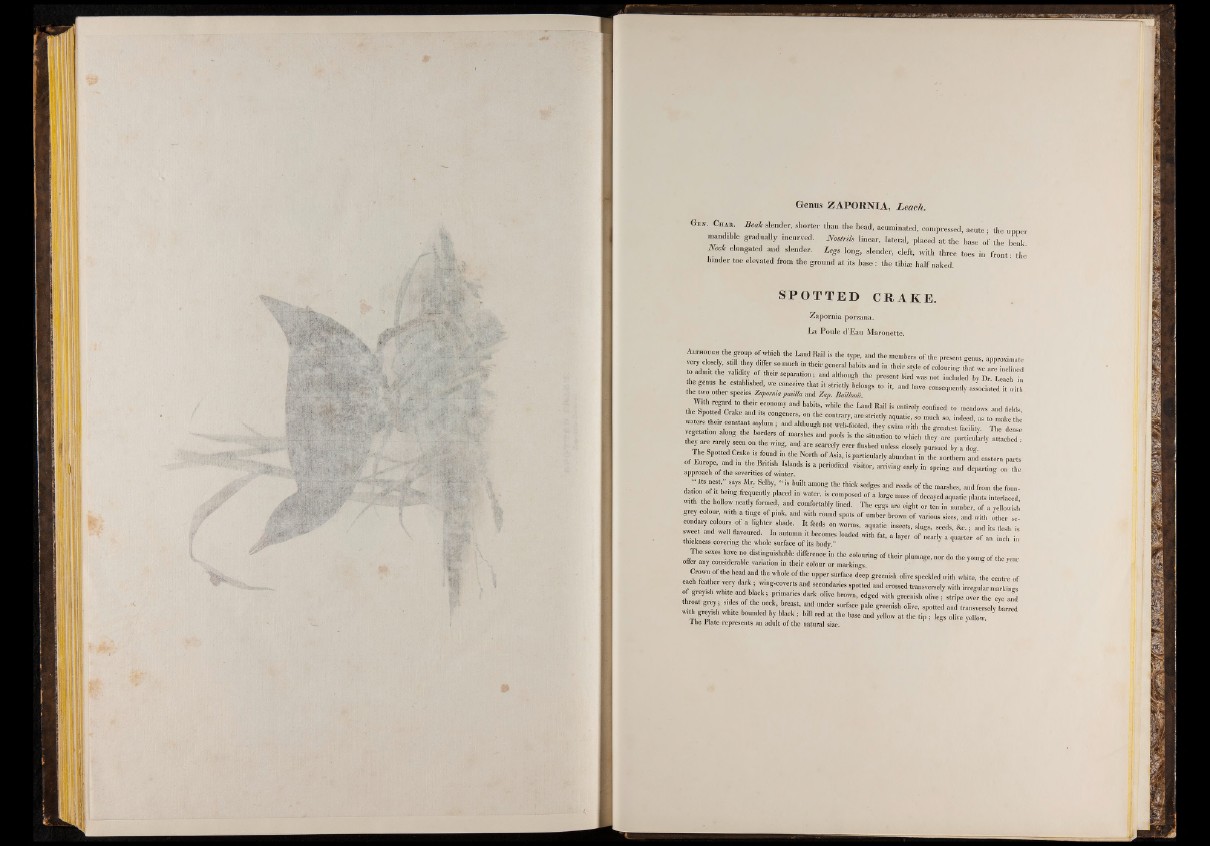
i - S f P 5
Genus ZAPORNIA, Leach.
Gen. Char. B e a k slender, shorter than the head, acnminated, compressed, acnte ; the upper
mandible gradually incurved. N o s tr ils linear, lateral, placed at the base of the beak
N e c k elongated and slender. L e g s long, slender, cleft, with three toes in front- the
hinder toe elevated from the ground at its base : the tibiae half naked.
S POT T ED CRAKE.
Z a p o rn ia porzana.
L a P o u le d’E a u Maronette.
AnrHouoH the group of which the Laud Rail is the type, and the membeni of the present genus, approximate
H B “ tbey W B m 1 R H habitS and in ,beir stIle of colouring 0 admit the validity of then separation; and although the present bird was not includetdh atb yw De ra.m L einacclhin eind
thhei Htwo othier species Z7a poHrnia puHsilla a‘nhda tZ Ia pB. Baillo bnei'i.°ngS '° 1 “ d bare consequently associated it with
1the H SpottHed Cra 1ke Hand itHe congIenaenrsd, boanW tthSe' cWobnitlrea trbye, aLrea nstdr Bictly aisq IuatBic, so cmonulcihn esdo , *i0n dmeeedad, oaws st oa nmda kfiee ltdltse
waters their constant asylum ; and although not web-footed, they swim witb the greatest facility. The dense
vegetation along the borders of marshes and pooh is the situation to which they are particnMy attached
they are ramly seen on the wing, and are scarcely ever flushed unless closely pnrL d by a dog. '
■Be Spotted Crake is found in the North of Asia, is particularly abnndan, in the northern and eastern parts
of Europe, and the BnUsh Islands is a periodical visitor, arriving early in spring and departing o„P ,h approach of the severities of winter.
| Its nest,” says Mr. Selby | is built among the thick sedges and reeds of the marshes, and from the fonn-
—with the hoWllow nmeatly mforme Pdl,a Canedd ,dco.Wmafoterrt'a ibsl yc olimnePd°.s edT ohfe «e Hggs a rme aesisg ohft doerc taeyne di na qnnuamtibe eprl,a ontfs ai nyteelrlloawceisdh,
grey colour, with a tinge ofp.uk, and with round spots of umber brown of various sizes, and with other se-
condary colours of a lighter shade. I, feeds on worms, aqnatie insects, sings, seeds, &c ; and its flesh is
sweet and well flavoured In autumn it becomes loaded with fat, a layer of nearly a quarter of an inch in
thickness covering the whole surface of its body.”
The sexes have no distinguishable difference in the colouring of their plumage, nor do the young of the year
offer any considerable variation in their colour or markings.
Crown of the head and the whole of the upper surface deep greenish olive speckled with white, the centre of
each feather very dark; wing-coverts and secondaries spotted and crossed transversely with irregular markings
of greyish white and black; primaries dark olive brown, edged with greenish olive; stripe ovfr the eye a„^
th oa, grey; sides of the neck breast, and under surface pale greenish olive, spotted and transversely barred
with greyish white bounded by black ; bill red at the base and yellow at the tip ; legs olive yellow
1 he Elate represents an adult of the natural size.